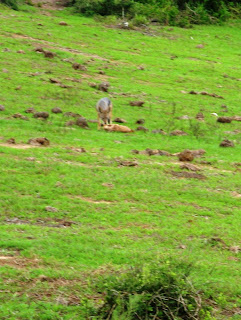The evening after my first post, Michael and I were invited to dinner at the Hotel Director's table. A formal dinner is a cruise tradition after the first full day at sea. Each officer hosts a table and the most senior in days on Silver Seas or the most distinguished guests are invited to dine with the officers. We have become acquainted with Bertrand, the Hotel Director, over the course of several cruises and were delighted to accept. Another couple who had many, many days on various cruise lines joined us. The conversation involved stories of past trips, anecdotes about cruise line staff and tales of various mishaps at sea. It was an entertaining evening.
Sunday morning we arrived in Port Elizabeth, South Africa. Port Elizabeth is a commercial port several hundred miles to the east of Cape Town. It is a relatively prosperous city, important to the South African auto industry. There is a large General Motors plant in the city and Volkswagen and Mercedes Benz plants are nearby.
We took a tour to the nearby Addo Elephant Park. Our motor coach drove through the city and north through rural areas. Here, as in Cape Town, the townships to which the black Africans were formerly forcibly relocated, are some distance out of town. Nowadays all people may live anywhere they please and can afford. Most of them chose to stay near family and friends. Thus, the black townships are mostly still all black and growing. The South African national government is building modern housing in the townships. The government has promised each family a house but it is a daunting prospect for them to deliver on the promises.
Near Cape Town, the townships are largely shantytowns of cardboard and tin shacks with some more modern housing. Port Elizabeth has a much higher proportion of small, neat cement block and stucco houses, most with solar heated hot water tanks on the roofs. There are some severe unintended consequences of the housing program and South Africa's relative prosperity and stability. Floods of undocumented refugees from other southern African countries, less stable or well off, are entering the country and settling in the townships. The unemployment rate is very high. Schools and social services are strained. The poverty-stricken shantytowns keep expanding. The political and social consequences could be dire.
Our motor coach drove north toward the national game park for about an hour. We observed "the bush", sandy or clay soils covered in scrubby bush, small trees and succulent plants. Our bus escort told us that most of the land was once cleared for farming. Many of the farms have been abandoned and the wild plants are again taking over. Farming in this part of South Africa is very difficult and younger sons and daughters are seeking other occupations. There is also an issue of farm violence. The guide was carefully not specific about who is committing this violence but there is obviously a severe problem. We saw dairy and fruit farms dotted about the countryside. There were also several very basic manufacturers of brick. The kilns were simply coal and mud packed around the dried clay bricks and set fire to burn for about a week.
As we neared the elephant refuge, we saw signs for a local cement company. The company has bought up a lot of acreage in order to mine limestone for cement production. They recently cut a deal with the national government to turn the land over to the game reserve when they have finished mining. This will eventually almost double the reserve's present size.
Our"safari" consisted of a drive through the bush on pretty good roads in an open sided four wheel drive vehicle that held about twenty people. Man-made waterholes were located conveniently close to the road. The driver/guide was in radio contact with the other drivers so they could all spot the same game. Even so, most of the game hid in the bushes away from sight. Addo was originally created to preserve the Addo Elephant native to the area. By the early 1930's the population had been hunted almost to extinction and only eleven elephants remained. With conservation and expansion of the park, the population of elephants is now near 500. In the past ten years the emphasis has shifted from preserving the Addo elephants to preserving their whole ecology. Addo now houses black rhino, lion, and kudu. Eland, wildebeest, warthogs and other originally indigenous animals have also been reintroduced.
Michael and I were able to spot and photograph some jackals at the first waterhole. At the next stop we saw some warthogs. This was followed by a turtle crossing the road. After a longish stretch of viewing grass, bushes and a few birds with beautiful blue mountains in the distance, we saw some meercats running across an open area. Another long stretch of riding up hill and down and we finally saw a glimpse of a kudu. Our guide told us that it had rained for the past three days and the animals were drinking from puddles instead of visiting the water holes. Maybe we would see elephants, maybe not. Of course, we found a small herd of elephants. The driver was in contact with all the others so, after an appropriate amount of suspense, there they were. It is show business, after all. Anyway, I had fun. The animals were real and it wasn't Disneyworld.
Our elephant adventure took a bit longer than the schedule allowed. We returned to the dock a few minutes late to find the gangway partially disassembled. The ship's crew hurried us aboard and the ship departed almost immediately. Our next stop on Tuesday is Maputo, Mozambique, a day and a half away.
--
Barbara Borsuk
barbara@mborsuk.com
Boulder, Colorado, USA
303 408-3639






No comments:
Post a Comment